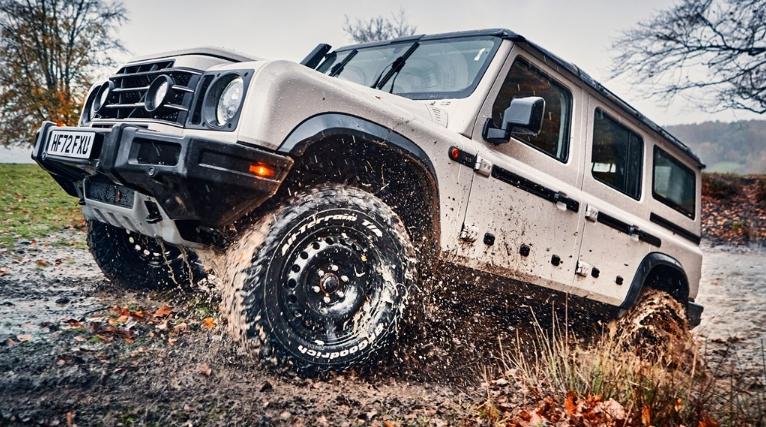
To get straight to the point, the Ineos Grenadier car is impressive. The Ineos Automotive team, with their debut vehicle, has done an excellent job. The car itself is not in question, but rather the driver’s abilities.
The Ineos Grenadier has fulfilled its purpose of being a modern version of the classic Land Rover Defender, which was discontinued in 2016 for various reasons, including its poor on-road performance. Ineos founder Sir Jim Ratcliffe, a passionate off-roader, disregarded these issues and created a vehicle that catered to his interests and the preferences of many others who enjoy off-roading.
So, let’s clarify what this car is and who it’s for. If you’ve driven a G-class Mercedes, a Q-series Audi, or any of BMW’s X-cars, you might think you’re an off-road enthusiast seeking adventure. However, these premium SUVs are primarily road cars with some off-road capability. The Grenadier, on the other hand, is designed to prioritize off-road ability over on-road sophistication. When you’re traversing the Outback, the Namibian desert, or leaving behind rooster tails through volcanic ash, you’ll appreciate the Grenadier’s ruggedness and simplicity. But on the M1 or the North Circular or the A66, it may not be the ideal ride.
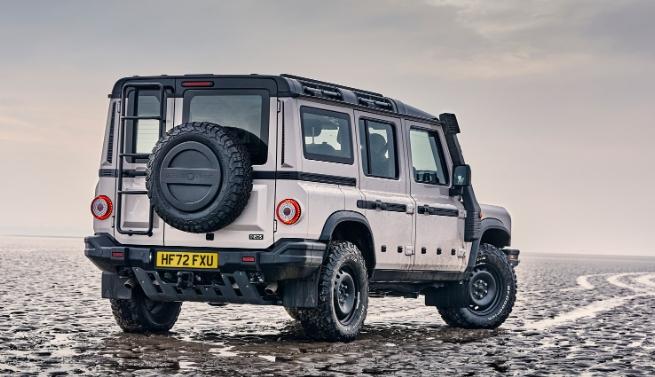
Rewind a bit. What exactly is the Grenadier?
In the UK, two versions of the Grenadier are available at first: the Station Wagon and the Utility Wagon. Both come with the option of either a petrol or a diesel engine, and share the same wheelbase and basic mechanics.
The conventional five-seater Station Wagon is the standard SUV option. It follows a similar design format as the current Land Rover Defender 110 and Mercedes G-Class. The boot capacity for this model is 1152 litres, and it increases to 2035 litres when the rear seats are split-folded.
The Utility Wagon version is designed for those who primarily use the Grenadier for work purposes. It features blanked-out rear windows and a more basic loadbay, providing 2088 litres of luggage space. In certain markets, a five-seat Utility Wagon is also available, offering 1255 litres of cargo capacity and slightly less space for rear passengers compared to the Station Wagon.
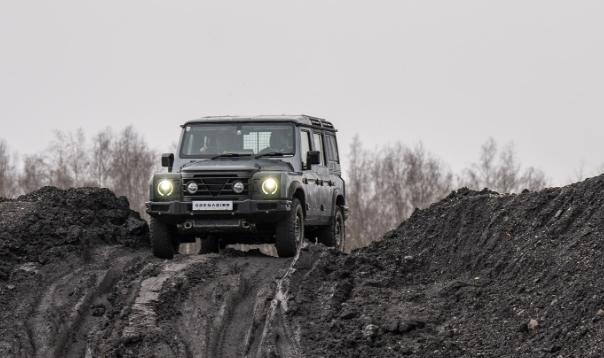
The Station Wagon comes in different trim levels, with various individual or bundled options available. Two special editions are named after Belstaff’s tough off-road motorcycle jackets, owned by Ineos. The Fieldmaster version comes with pop-up “safari” sunroofs above the driver and front passenger, heated front seats, and leather upholstery. The Trialmaster version is built for extreme off-road use, with a snorkel, 17-inch alloy wheels, front and rear differential locks, and a rear-mounted ladder for easy roof access.
The Grenadier is priced starting from £55,000 for the Utility Wagon and from £58,000 for the Station Wagon in the UK, regardless of petrol or diesel engine. However, the majority of orders are for the Belstaff editions, which have a starting price of £69,000.
What’s it like to drive?
The performance of the Grenadier depends on the engine and the driving environment. Your expectations also play a significant role. If you’re used to the luxury of BMW X5 or current Defender, you may find the Grenadier lacking in sophistication and speed on the road. Additionally, the steering feels vague and imprecise. However, the on-road ride quality is excellent, the cabin is relatively quiet, and the seats (which can be manually adjusted) are comfortable.
During our two-day test, our initial impressions of the Ineos Grenadier were not positive. We quickly noticed that the front wipers were poorly designed, leaving a large dirty area next to the A-pillar, which was already obstructing a significant portion of the driver’s view. When the low sun appeared, lowering the visor rendered even more of the already shallow screen useless.
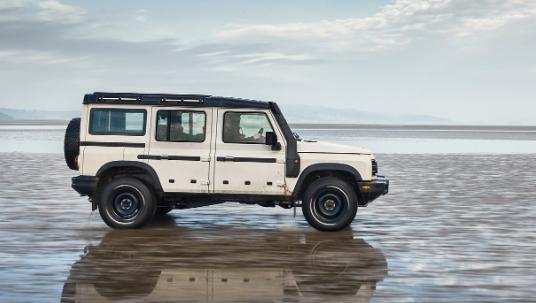
Furthermore, the rear view from the central mirror is even more disappointing as the unique off-centre split design of the rear doors obstructs the view of a considerable portion of the road behind. The rear wiper arc is also frustratingly focused on cleaning the area of the glass that is already covered by the spare wheel.
While driving on the road, the steering of the Grenadier feels both light and fidgety, and the diesel engine in our initial test vehicle feels unsettled, frequently changing gears through the eight-speed auto gearbox. It’s a bit peculiar, given that the 3.0-litre six-cylinder BMW engine is a reliable unit that doesn’t feel like this in other applications.
As we move off-road and the weather worsens, the Grenadier’s performance improves. With the help of hill descent control, permanent all-wheel drive, locking centre differential, optional locking front and rear differentials, and other electronic aids, the Grenadier is capable of amazing feats. It descends down a steep and slippery slope to a beach, navigates through rocks covered with hazardous seaweed, and then climbs back up the increasingly deep-rutted and gloopy slope.
On the first day of our test drive, we were only driving the diesel version of the Grenadier, which left us with mixed feelings. The steering on the road still felt light and unstable, and the diesel engine didn’t perform as expected, frequently changing gears through the automatic gearbox. Even though the BMW 3.0-litre six-cylinder engine is a proven unit, it didn’t seem to perform as well as it does in other vehicles.
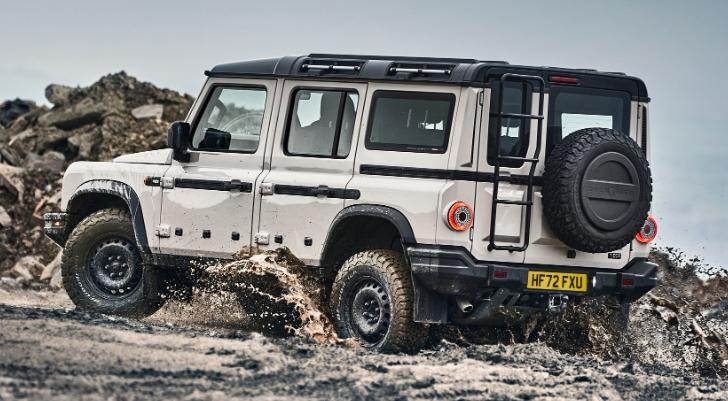
However, the second day was a different story as we drove the petrol versions, which were much smoother, more responsive, and better coordinated with the transmission. Although the steering still didn’t feel quite right for road use, the petrol engine felt just as capable off-road as the diesel engine. Unfortunately, the poorly designed wipers remained an issue.
On the second day of testing, the petrol versions were used for a mix of on and off-road driving, including some faster road stretches. Despite the steering still being a bit off for road use and the wipers still being problematic, the petrol engines provided a smoother, more responsive drive that seemed better coordinated with the transmission. Even off-road, the petrol engine didn’t feel inferior to the diesel, which is typically torquier. The off-road driving on day two consisted of many miles of bumpy, narrow tracks, often crossed by streams. The Grenadier handled the terrain with ease, even with a semi-competent driver who kept getting distracted by the scenery. The petrol version is faster and more enjoyable on the road than the diesel, but neither is particularly fuel-efficient, with the petrol version getting between 18.9-19.6mpg and the diesel version getting 23.1-26.9mpg.
Talk us around all those levers and knobs…
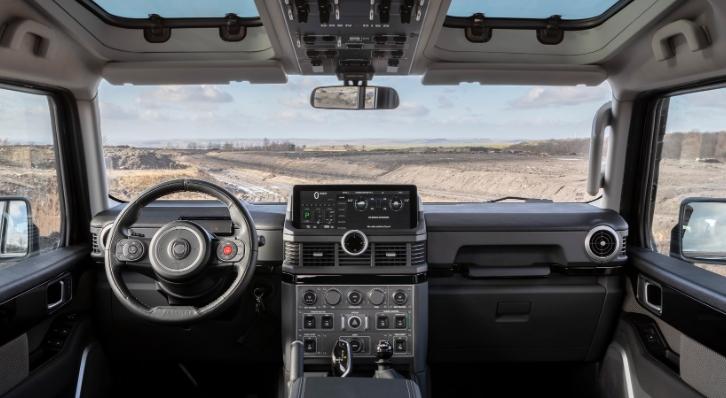
The Grenadier may not have a fancy interior, but it’s designed to withstand muddy environments and can be easily wiped down. The driver-friendly cabin has chunky buttons that are easy to use while wearing gloves, a traditional handbrake, and a lever to engage the central diff lock and switch between gear sets. Though it lacks leather and wood trim, the vehicle does come with cloth, vinyl, and plastic materials. The interior has more to offer than meets the eye, with front and rear USB slots and a rotary controller, which is essentially a BMW iDrive controller with Ineos branding. While the iDrive system is reliable and easy to use for adjusting navigation, entertainment, and other features, the Grenadier’s interior also has more buttons than most BMW vehicles.
The Grenadier’s overhead control panel is unique, taking inspiration from boats and planes rather than other cars. It’s both visually appealing and functional, housing buttons and switches for off-road functions like the front and rear diff locks, downhill assist, and off-road mode. The small screen in front of the driver is limited to warning lights such as the diff lock, while all other information is displayed on the central screen.
The steering wheel has a few buttons, including one labeled ‘toot’ that produces a quiet horn sound to alert cyclists of your presence. Overall, the driver’s seat experience is reminiscent of a less luxurious G-Class.
Ineos Grenadier: verdict
If you have a realistic understanding of what it is and what it isn’t, the Grenadier is a smart choice. It competes with robust SUVs such as the Toyota Land Cruiser and non-AMG Mercedes G-Class, as well as pick-ups like the Ford Ranger and Toyota Hilux. In this context, where toughness and practicality are more critical than sharp handling and high-tech displays, the Grenadier is a well-designed interpretation of a proven concept.
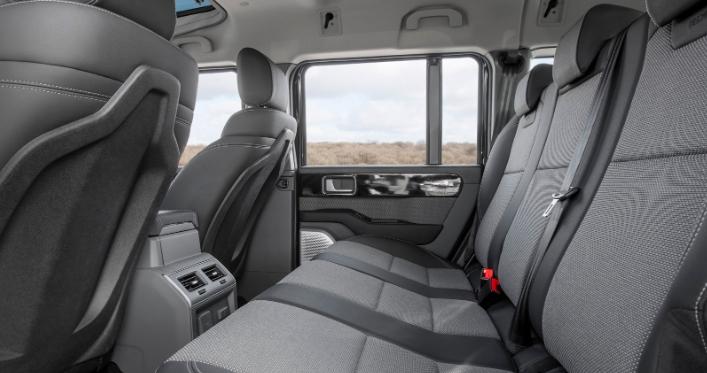
While the Grenadier’s impressive looks may be a bonus, those who purchase it solely for its appearance may be disappointed if they intend to use it as a family car on the road. It would be more prudent for such individuals to wait for one of the other vehicles planned by Ineos Automotive. However, for those who understand the Grenadier’s purpose as a rugged and capable off-roader, it is a well-executed version of an established idea, and competes favorably with other durable SUVs and pickups such as the Toyota Land Cruiser, non-AMG Mercedes G-Class, Ford Ranger, and Toyota Hilux.
A prototype of an electric 4×4 will soon be revealed, and it is expected to enter production by 2026. The electric 4×4 will resemble a slightly smaller Grenadier and will have most of its off-road capabilities. Ineos Automotive is also exploring the use of hydrogen fuel cells. Additionally, there is a plan to replace the current BMW engines with mild-hybrid versions in the future.
In the near future, a double-cab pick-up version of the Grenadier will be released, which will utilize a longer-wheelbase chassis. Furthermore, the long-wheelbase chassis is expected to give rise to a seven-seater Station Wagon in the long term.
- Share:
